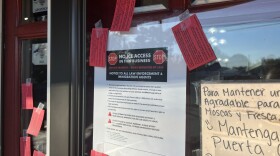Different neighborhoods in Raleigh and Durham experience heat unevenly and inequitably depending on several factors, according to recently released results of a community-led study.
The study's report found a maximum temperature difference of 9.6 degrees between the hottest and coolest areas of Raleigh, and a maximum temperature difference of 10.4 degrees in Durham.
"This is a difference likely only to increase in disparity when we see hotter days or genuine heat waves," said Max Cawley, a study organizer and Program Manager for Public Engagement at the Durham Museum of Life and Science. "The findings show with great confidence the geographic distribution of heat is indeed an important feat, but it's also only the first of many steps in reckoning with and rectifying the circumstances."
On July 23, 2021, 165 volunteers across Raleigh and Durham collected heat data along 19 different routes three separate times throughout the day (early morning, afternoon and evening). Volunteers collected almost 100,000 total individual measurements.
Raleigh and Durham participated in this national study along with New York City, San Diego and 11 other major cities across the United States. The National Oceanographic and Atmospheric Association is a major sponsor of the study program.
Uneven distribution of heat
Metropolitan areas tend to get much warmer than outlying rural or suburban districts. Temperatures in urban regions are amplified by paved surfaces that absorb and retain heat, including roads, parking lots and buildings. Meanwhile, suburbs or rural communities have less dense development and more greenery that provide shade and natural cooling.
This trend is shown in the maps of collected data.
"The hottest areas of the city are really standing out in these afternoon maps," said Myleigh Neill with the North Carolina State Climate Office. "In Durham, we see the campus of North Carolina Central University that's really standing out as well as the Northgate Mall area. In Raleigh, downtown is standing out as well as the fairgrounds."
But even in urban areas just a few blocks or miles apart, heat is felt differently. For example, data showed Nash Square in downtown Raleigh had a slightly lower temperature than surrounding streets.

"If you're familiar with that area, you'll know that it has a ton of trees just in that one square block," Neill said. "You can really see the cooling effect of those trees very clearly here."
Past racist policies of redlining also contributes to how heat is felt differently now. Redlining was a federal government policy from the early and mid-20th century that mapped where Black residents lived and were therefore deemed "risky investments."
According to Cawley, it's often low income communities and people of color who now feel more heat disproportionate to more wealthy areas.
"[Raleigh and Durham have] a painful legacy of racist and exclusionary policy," Cawley said. "[This data is] a starting point for making better decisions in the future."
Local solutions to address heat disparities
The city of Raleigh and Durham County plan to use these results to inform new policies on how to better mitigate and adapt to the uneven distribution of heat.
Possible solutions include adding more greenspaces and offering residents access to cooling assistance and centers. Future construction projects can also plan on using lighter colored surfaces that retain less heat than darker colors.
"Heat mitigation work is a really important part of our work to combat climate change," said Megan Anderson, sustainability manager for the city of Raleigh. "Extreme heat is one of the top climate change stressors in our region. We really need to think about how we can create strategies that will protect those in our community who are most sensitive to heat."









